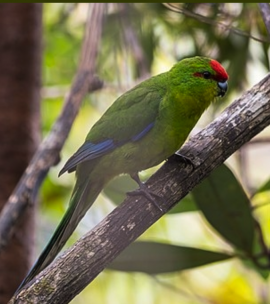New Caledonian Parakeet |
|
|
Photos
View in GalleryDid You Know?
Co-operative breeding has been reported in these parakeets. Genetic evidence suggests that the species is polyandrous (many males to one female).
Programs & Projects
WPT has worked with numerous partners to help save this species. Learn moreAcademic Research
Related publications: Cyanoramphus saissetiSpecies Profile
Genus: Cyanoramphus | Species: saisseti
Size:
26cm (10.2in)
Weight:
100g (3.5oz)
Subspecies including nominate:
one
Colour Adult:
Bright green in general. Red frontal band, lores and line through eye. Narrow red line on ear-coverts. Center of crown red extending back to above eye. Yellow-green superciliary area. Red patch on either side of rump. Primary wing coverts, alulua and outerwebs of primaries violet-blue; fine yellow outer margin to outer primaries. Wing-bar in some males. Bright yellow throat, underparts yellow-green. Uppertail green lightly washed with blue; undertail dark grey. Bill blue-grey tipped with black. Eye dark red. Females usually have wingbar.
Colour Juvenile:
Juveniles show wingbar, otherwise as in adult.
Call:
Quiet short notes; melodic.
Listen NowVideo Links:
Video 1 | Video 2More Information:
Content Sources:
CITES
Parrots of the World, Forshaw, 2010.
Cornell Lab of Ornithology/Birds of the World
A Guide to Parrots of the World, Juniper and Parr, 1998.
xeno-canto New Caledonian Parakeet, Aberg, Patrik, XC40162
Research: Spatial ecology and conservation of parrots of New Caledonia
Parrots in Aviculture, Low, 1992.
Lexicon of Parrots, Thomas Arndt.
Photos
View in GalleryDid You Know?
Co-operative breeding has been reported in these parakeets. Genetic evidence suggests that the species is polyandrous (many males to one female).
Programs & Projects
WPT has worked with numerous partners to help save this species. Learn moreAcademic Research
Related publications: Cyanoramphus saissetiSpecies Care
Captive Status:
Not recorded.
Longevity:
Probably similar to C. novaezelandiae: 10 years
Housing:
Most likely similar to C. novaezelandiae: Aviary at least 3.5 x 1 x 2m (10 x 3 x ft). Free-flying possible. Provide protection from cold.
Diet:
Probably as in C. novaezelandiae: Small seed mix such as: canary, millet and smaller amounts of oats, buckwheat, safflower and a little hemp; limited sunflower seed; spray millet; green leaves such as: Swiss chard, lettuce, sowthistle, dandelion, chickweed; seeding grasses; rearing food made from hard-boiled egg, wholegrain bread and carrot, all ground to crumbly consistency; complete pellet.
Enrichment:
Probably similar to C. novaezelandiae: Love to climb, therefore provide ladders, ropes and swings; not a vigorous chewer. Provide large flight for exercise. Provide areas for bathing.
Nest Box Size:
Vertical box 8" x 8" x 14" (20.3cm x 20.3cm x 35.5cm).
Clutch Size:
2-4
Incubation Time:
19 days
Fledging Age:
Probably as in C. novaezelandiae: 5-6 weeks
Hatch Weight:
Not recorded.
Peak Weight:
Not recorded.
Weaning Weight:
Not recorded.
Photos
View in GalleryDid You Know?
Co-operative breeding has been reported in these parakeets. Genetic evidence suggests that the species is polyandrous (many males to one female).
Programs & Projects
WPT has worked with numerous partners to help save this species. Learn moreAcademic Research
Related publications: Cyanoramphus saissetiSpecies Wild Status
World Population:
2500-10,000
IUCN Red List Status:
Near Threatened (as conspecific with C. novaezelandiae)
CITES Listing:
Appendix I
Threat Summary:
It is suspected to be declining due to the effects of predation by invasive species. In the near future it may decline more rapidly if habitat is lost to nickel mining.
Range:
Found on New Caledonia.
Habitat:
Found in indigenous montane forests.
Wild Diet:
Feeds on fruits and seeds of casuarinas and pawpaws Carica papaya, and other plants.
Ecology and Behaviour:
This species has a scattered range, mostly rain forest and forest edges. There are also reports that it tolerates Niaouli savanna, Maquis scrub and humid forest to 1,500m. It is most abundant in Gymnostoma preforests and in wet forests from 400-800m. Quiet and difficult to observe in canopy. Will forage for seeds on the ground.
Clutch and Egg Size:
2-4
Breeding Season:
November-January. Nest is in tree hollow.
Related Links:
Research: Spatial ecology and conservation of parrots in New Caledonia
Photos
View in GalleryDid You Know?
Co-operative breeding has been reported in these parakeets. Genetic evidence suggests that the species is polyandrous (many males to one female).
Programs & Projects
WPT has worked with numerous partners to help save this species. Learn moreAcademic Research
Related publications: Cyanoramphus saissetiMembers Only Resources
Please log-in now to find more research, resources and tools.
Not a Member?
Find more great information:
Gain exclusive access to 600+ pages of additional research, seminars and podcasts, specialists to ask your toughest questions, and dozens of other fun resources - when you become a WPT member.
Join Today >>

































